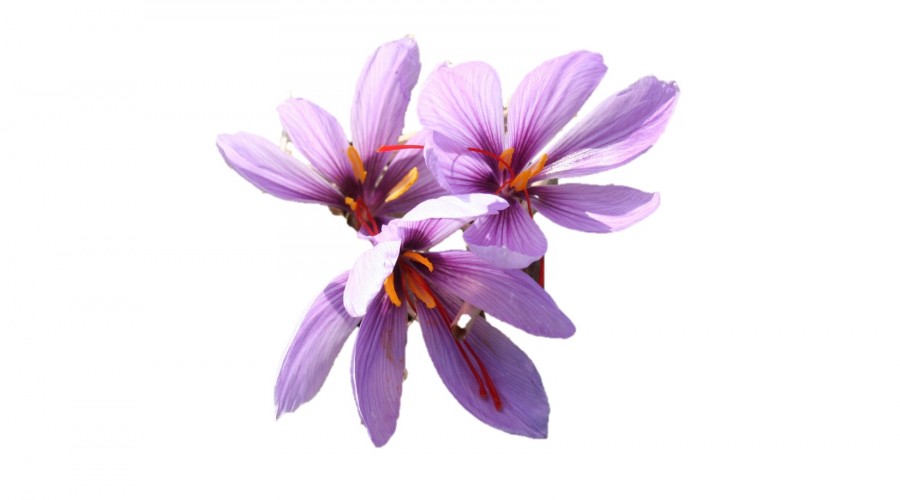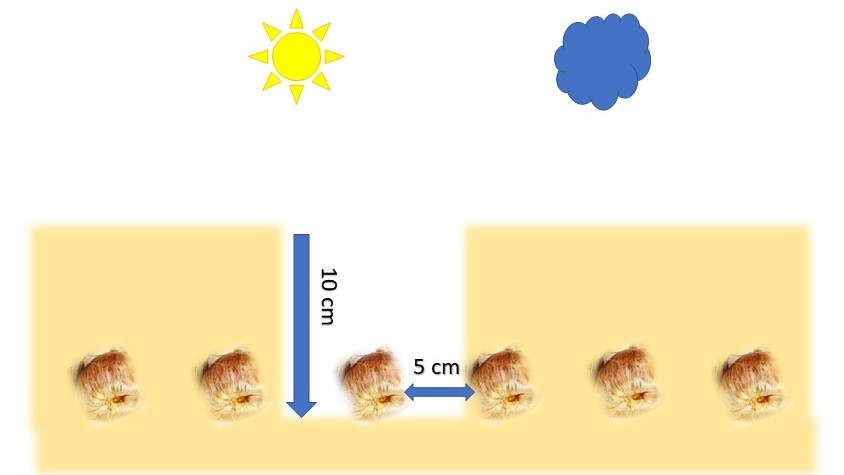Planting the bulbs in the open soil
Make sure the soil is not too dry before planting and that there are no large, hard lumps of soil in the plot. This would make it difficult to plant. (Larger stones and boulders should also be removed).
Dig a hole of 8-10 cm deep and put a bulb in the soil. The tip of the bulb should preferably point upwards. To be able to thrive, and to have enough room for the multiplication process after flowering (each mother bulb can get one or more new bulbs, up to 8-9 new bulbs; the mother bulb dies in this process), there must be a space of 5 centimeters between the bulbs.
As already mentioned, the tip of the sphere must eventually point upwards. When the Crocus sativus bulb ends up crooked in the ground, the roots will pull the bulb into the right position during the growing stage.
After flowering in October-November, the bulb is ready with the big commission for the season: the annual flower with the Saffron is delivered.
Green leaves crucial for propagation process (October/November – April/May)
In a period of 7-8 months after the completion of the harvest (October/November – May/June), the bulb will automatically start shedding its leaves (the leaves will slowly turn yellow and brown in the new year): you must not cut the leaves yourself! The reason is that the leaves absorb sunlight (the process of photosynthesis), which is necessary to allow new bulbs to grow beneath the surface, i.e. outside our field of vision, and thus to enable the development for the coming years.
The multiplication of your bulbs will take place during this period (November – May/June). Water and fertiliser are very much needed in this active growth period of the bulb.
Dying off of the leaves
Especially late in the season (April-May) the leaves become increasingly yellow and brown: they die off. As soon as no more than 50% of the leaves are still green, you should stop watering and absolutely do not apply any fertilizers anymore! The bulbs will then have a rest, in the (preferably hot) summer period. After a few months (August-September) the bulbs will start with the beginning of the next growth cycle.
Planting & Growing Crocus sativus bulbs in Pots, Barrels, Wooden Crates or Bins
Many people choose to grow a small amount of Saffron at home, to observe the wonders of this spice from closeby. In most cases people use pots or bins, on the balcony or around the house. Here too, it is necessary to pay sufficient attention to the environment and the soil in which the bulb has to grow and blossom. To help you make a good start, we have tried to provide some guidelines and ideas.
First of all the “housing”. Find a large pot or container without a hole in the bottom. The reason for this is that when you give water, most of the water will drain out immediately at the bottom if the housing (the pot, bin, container) is not closed at the bottom.
Fill the pot, crate or tray with:
- at the bottom first a layer of hydro grains
- above that you fill the pot with potting soil.
The water drainage: in case there is too much water in the pot or bin, this can be discharged through a hole that can be applied by yourself at the height of the upper hydro grains (so a few centimeters from the bottom, on the side of the container). This ensures that the container never dries, and there is sufficient moisture (between the hydro grains), but that the roots are not flooded. You can also use pot shards instead of hydro grains.
See the illustrations below:
At the bottom of the pot, put a layer of pot shards or Hydro grains.
Fill the pot with potting soil, and make a hole above the Hydro grains level for water drainage.

For good water management in your pots it is crucial that the potting soil is permeable to water and does not retain all water for a longer period of time. Nutrition can be added during the growing period. This is only allowed as long as there is plenty of leaf green visible above the soil. When the leaves are dying and 50% or more of green leaves has withered in April-May, absolutely no nutrition should be given. You should also no longer give water. Allow the bulbs to enter the stage of dryness and “summer sleep”.
The Crocus sativus bulbs will not thrive in extremely watery soils. So keep an eye on the soil in the pot: especially after rain showers the soil may be too wet and stay wet for too long.
Please note: Flower bulbs are always more sensitive to frost damage when they live in pots and containers due to thin walls. In case of severe frost it is advisable to temporarily put the pots inside until the frost has passed.
Place your pot, barrel or bin with Saffron bulbs in a spot around your house where they get the most sun. Saffron bulbs have a preference for an average amount of moisture in the spring, but prefer absolute drought in the summer when they actually sleep.
The actual planting of the bulbs in the pot of container
Dig a hole of 8-10 cm deep and put the bulb in the potting soil. The tip of the plant must point upwards. Always leave 5 cm of space around the bulb. The number of bulbs that can be planted in a pot therefore depends entirely on the size of the pot. Please remember that also from the side of the pot, there has to be 5 centimeters distance and space inwards for each bulb.
So you always have limited space in a pot: do not deviate from the indicated space for each bulb. After 1 cycle, when you remove the bulbs from the pot in June, you will better understand why we make this recommendation. The space (diameter) that each bulb now occupies, in June, is much larger than when you planted the first bulbs in August / September of the year before: the mother has been succeeded by a number of youngsters, who together take up a lot more space than the mother did.
The roots of the mother bulb will form in autumn. You can give water about 4-6 weeks before the bulbs come to flower. Leaves will develop around or after flowering in Oct-Nov. The same process takes place in the pot as with the bulbs in the field: The bulb automatically repels its leaf; do not cut off the leaves!
Remember – Crocus sativus Saffron bulbs are fall bloomers. Unlike almost all its family members, who bloom in early spring!
Would you also like to grow Saffron in your own garden or on your balcony? Order your Crocus sativus Saffron bulbs here on the Crocussativus.eu website.






